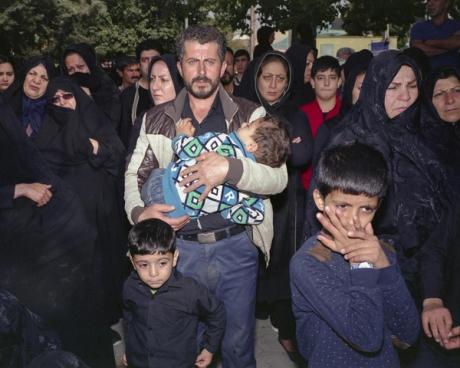
Tehran-based artists say they have continued to work despite unrest in the country following the death of Mahsa Amini last September. Alborz Kazemi, a photographer who studied painting at the School of Fine Arts in Tehran, says the Iranian capital’s art scene has been “negatively affected” by recent upheavals but “many artists have continued to work” .
Amini died in an Iranian hospital after being detained by the regime’s vice police for failing to follow the country’s hijab regulations. His death has sparked ongoing mass protests in Tehran and cities across Iran as well as demonstrations across the world. The government crackdown that followed resulted in the deaths of more than 500 protesters according to the US-based Human Rights Activists News Agency.
Kazemi is currently showing the work What happened? (2021) at the temporary exhibition Realism organized by Dastan Gallery which is held in Frieze’s No. 9 Cork Street space. “I will definitely continue to work here [in Iran] and making art here despite all its challenges and difficulties. Things move so fast here that sometimes it’s hard to keep up. Prices are changing daily, inflation is out of control and because of sanctions [including those imposed by the US in March], a lot of the materials and tools we need aren’t even there. But we are doing what we have to do,” he said.
Filmmaker Mamali Shafahi, also a creator of sculptures and installations, also took part in the Realism to show (The House of Bardo 02, 2023). He says it has been “a really tough time for artists in Iran.” Most shopping malls have been closed for a few months but there is “less tension” now. “The artists asked for the reopening of the galleries, which mainly tried to support them by continuing to sell their works.”
In the Realism exhibition, the 24 participating artists “substantiated their experiences, observations, and emotions through painterly marks and sculptural forms,” a statement from the gallery reads. One of the works of Shohreh Mehran (Untitled2023), depicts young women carrying textbooks (in recent months there have been numerous reports of poisoned schoolgirls and more than 1,000 people have been affected).
“A lot of books [in Realism] have not been made in the past year, but they can be found more relevant today,” says Hormoz Hematian, the founding director of Dastan. “I think we can show all these works in Iran, but ultimately the works have to be reviewed by the visual arts department of the Ministry of Culture.”
Filmmaker Nik Yousefi in particular has turned his anger on the state. He was arrested last October after releasing Baraye Farzandaneman (2022) which shows empowered, hijab-less women fighting men in a series of violent battles. Yousefi, who has since been released, told his Instagram followers that the film was made “for the sake of our children”.
Curator and independent consultant Dina Nasser-Khadivi says Yousefi has been “incredible. He came out in solidarity with women in shorts, which is forbidden”. She tracks protests inside and outside Iran, pointing out that Iranian authorities have arrested more than 20,000 people during the current unrest.
“It has become a cultural revolution. There has been a profound shift both within the country and in the diaspora globally. There is no turning back,” she adds. Nasser-Khadivi founded the collective behind the #postitforwardwlf campaign which aims to raise awareness in the art world about the ongoing struggle for greater freedoms in Iran.
Prominent artistic figures, including curator Hans Ulrich Obrist and artists Theaster Gates and Marina Abramovic, waved the campaign t-shirt or carried the tote bag, encrusted with a special QR code, to express their solidarity with movement.
“Today, our collective is present on six continents and continues to expand geographically and creatively. We will be in over 30 cities by next month,” says Nasser-Khadivi.
• Dastan Gallery: Realism, 9 Cork Street, FrieslandLondon, until April 29
